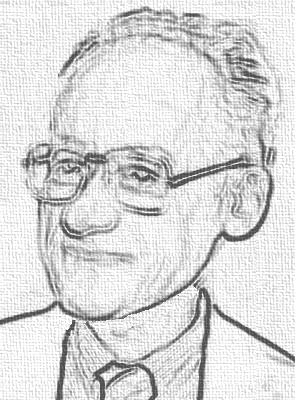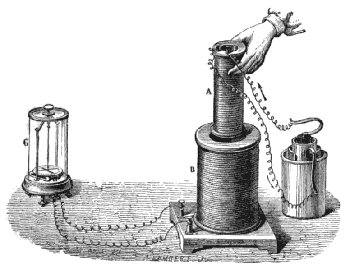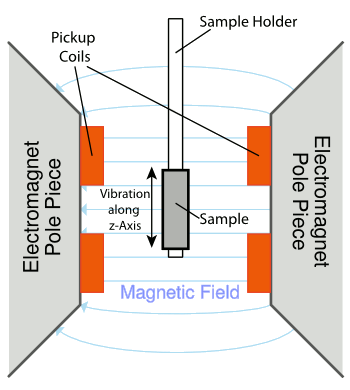Simon Foner and the Vibrating Sample Magnetometer
August 23, 2013
Not all
scientific information is transmitted via
journal articles. Even today, when the latest discoveries can be transmitted instantaneously over the
Internet, scientists feel a need for personal contact, so they attend
topical conferences. It's a great way, especially for younger
scientists, to meet people, and it's an excellent way to build
collaborative research teams which often transcend
national boundaries.
Early in my career I worked with
magnetic and
superconducting materials, and one topical conference in these areas was the
Annual Conference on Magnetism and Magnetic Materials. As for other conferences, the most important room isn't any of the parallel session rooms, but the
coffee room. Not only does the coffee
keep you awake during some of the less notable presentations, but it gives you a valid excuse to sit and talk with
colleagues. The coffee room is so popular, that most
poster sessions are held in the coffee room.
During one trip to the coffee room, I noticed an acquaintance seated with an older scientist whom I didn't recognize, so I sat to talk with them. The older scientist was Simon Foner, who was well known among magneticians (yes, that's the word we use) for inventing the
vibrating sample magnetometer.[1-3]
Si, as he was called, was a
Pittsburgh native. I had a
fellowship at the
University of Pittsburgh at that time, so we had a few talking points. Si, who had a very direct manner, then proceeded to dissect a presentation made one of my colleagues at the conference. I felt some loyalty to my colleague, and I thought that the
criticism was a little too harsh. As I later found, Si was just being Si. Later, the colleague admitted that the criticism was warranted, since his
model had so many
parameters it could probably fit any
experimental data.

Simon Foner (August 13, 1925 - October 2, 2007)
As reported in his Physics Today obituary by Robert P. Guertin and Lawrence G. Rubin, Foner was "...a tireless tinkerer with experimental apparatus, a restless gadfly, and an uncontrollable and incorrigible punster..."[4]
(Sketch derived from Internet photographs.)
Simon Foner was born on August 13, 1925, in Pittsburgh,
Pennsylvania. Towards the end of
World War II, Foner served in the
US Navy as a
sonar technician in the
Pacific.[4] His hands-on
electronics experience was to serve him well in later years. After the war, Foner attended what's now
Carnegie-Mellon University for his
undergraduate education through his 1952
Ph.D. under Emerson M. Pugh.[4,6]
After his Ph.D., Foner became a staff
physicist at
MIT Lincoln Laboratory, where he
invented and
patented the vibrating sample magnetometer (VSM).[3] One way to infer the
magnetic moment of a material is by
Faraday's law of induction, the simplest demonstration of which is dropping a
bar magnet through a
coil of wire and observing the generated
voltage.
Faraday's original
experiment is shown below.

A drawing of Faraday's original induction experiment of 1831. In this case, the magnet is an electromagnet, which causes a current flow trough the larger coil when it's moved. Movement is essential. A stationary magnet causes no current flow.
(Via Wikimedia Commons.)
Generally, you aren't interested in taking data on just permanent magnets, but on the magnetic response (
magnetic induction, commonly symbolized as
B) of materials in response to an
applied magnetic field (
H). The electric field generated in a coil through induction by small samples is very small, and it would likely be masked by those generated by a ramping applied field, or by magnetic
noise.
When Foner started his magnetics research, most
laboratory magnets were of the pole-type in which the magnetic field was localized in a small gap between
pole pieces, and the magnetic field was along the axis of these pole pieces. It's hard to generate motion along the pole axis. The vibrating sample magnetometer solved this problem, and also the problem of nulling the voltage of a changing applied field. In a VSM, the sample motion is
perpendicular to the applied field, and there are pickup coils whose axes are likewise perpendicular to the applied field (see figure). Sensitivity was enhanced through the use of a
phase-sensitive detector, commonly called a "lock-in amplifier."

A simplified diagram of a vibrating sample magnetometer
In this case, four coils with axes perpendicular to the magnetic field lines are used to attain greater sensitivity and reduced sample positioning errors. Foner gives many possible coil arrangements in his paper.[1]
(Modified Wikimedia Commons image.)
The
Francis Bitter Magnet Laboratory, named after
American physicist,
Francis Bitter, was founded at
MIT in 1961. Bitter was a pioneer in the generation of high magnetic fields. Foner was a founding member of the laboratory and became its chief scientist, and then its associate director from 1988-1989.[4]
Foner was very active in the physics community, serving in many positions in the
American Physical Society, including that of
consulting editor of the
Review of Scientific Instruments, in which his VSM paper was published. He served, also, as
chairman of the
IEEE Magnetics Society, and he was an
advisory editor of the
Journal of Magnetism and Magnetic Materials for more than a decade.[4]
Scientists are known outside their local circle by their
publications. Foner was an author of more than 400 scientific papers, and he edited four books on superconductivity, magnetism, and their applications. He was a
fellow of three organizations in which I'm a member, the
Institute of Electrical and Electronics Engineers, the American Physical Society, and the
American Association for the Advancement of Science.[4]
Foner was a recipient of the
IEEE Millennium Medal, awarded by the IEEE Magnetics Society; and the
1999 Joseph F. Keithley Award for Advances in Measurement Science by the American Physical Society for his invention of the vibrating sample magnetometer.[5] Simon Foner died on October 2, 2007.
References:
- S. Foner, "Versatile and Sensitive Vibrating-Sample Magnetometer," Rev. Sci. Instr., vol. 30, no. 7 (July. 1959), pp. 548-558. A PDF copy can be found here.
- S. Foner, "The vibrating sample magnetometer: Experiences of a volunteer (invited)," J. Appl. Phys. vol. 79, no. 8 (April 15, 1996), pp. 4740ff., doi:10.1063/1.361657 [6 pages]
- Simon Foner, "Magnetic Test Apparatus," US Patent No. 2,946,948, July 26, 1960.
- Robert P. Guertin and Lawrence G. Rubin, "Death notice - Simon Foner 13 August 1925 - 02 October 2007," Physics Today, November 15, 2007.
- Lincoln Lab's Foner, 82, and Sandholm, 76, MIT Press Release, November 28, 2007.
- L. Berger, "Obituary, Emerson M. Pugh," Physics Today, vol. 35, no. 3 (March, 1982), p.76. Emerson M. Pugh is sometimes confused with his son, Emerson William Pugh, the author of many books about IBM.
Permanent Link to this article
Linked Keywords: Science; scientific; journal; Internet; academic conference; topical conference; scientist; collaboration; collaborative; research; nation; national; border; boundary; magnetism; magnetic; superconductivity; superconducting; material; Annual Conference on Magnetism and Magnetic Materials; coffee; caffeine; collegiality; colleague; poster session; vibrating sample magnetometer; Pittsburgh; postdoctoral research; fellowship; University of Pittsburgh; criticism; mathematical model; parameter; experiment; data; Pennsylvania; World War II; United States Navy; sonar; technician; Pacific Ocean; electronics; Carnegie-Mellon University; undergraduate education; Doctor of Philosophy; Ph.D.; physicist; MIT Lincoln Laboratory; invention; patent; magnetic moment; electromagnetic induction; Faraday's law of induction; bar magnet; solenoid; coil of wire; voltage; Michael Faraday; experiment; electromagnet; electric current; Wikimedia Commons; magnetic field; magnetic induction; applied magnetic field; noise; laboratory; pole piece; perpendicular; phase-sensitive detector; lock-in amplifier; Francis Bitter Magnet Laboratory; American; physicist; Francis Bitter; Massachusetts Institute of Technology; MIT; American Physical Society; editorial board; consulting editor; Review of Scientific Instruments; chairman; IEEE Magnetics Society; advisory editor; Journal of Magnetism and Magnetic Materials; scientific literature; publication; fellow; Institute of Electrical and Electronics Engineers; American Association for the Advancement of Science; IEEE Millennium Medal.